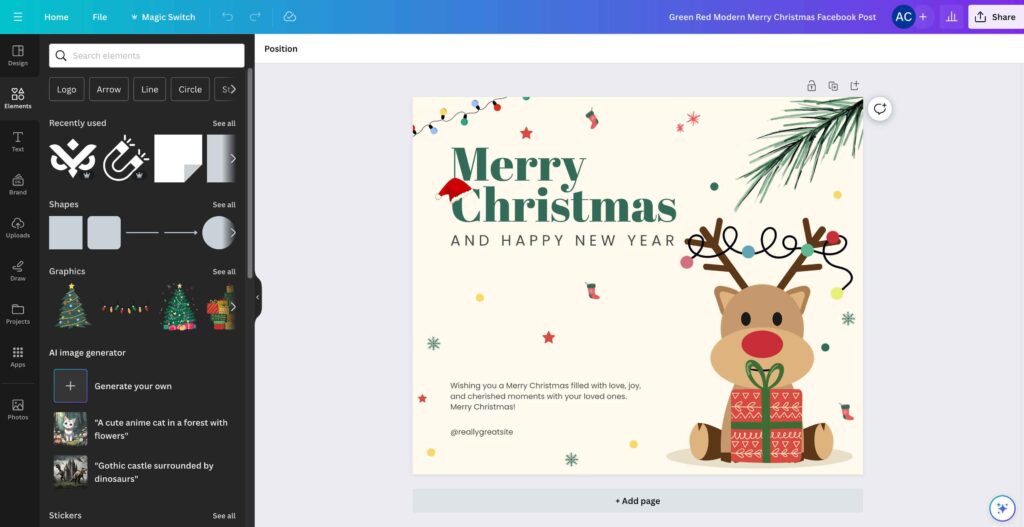Canva vs. Adobe Express - A Detailed Comparison
In this comprehensive comparison, we will delve deep into the world of graphic design software by examining Canva and Adobe Express, two of the most prominent players in the field. Our aim is to provide you with a thorough understanding of their features, ease of use, and what sets them apart.
- Ease of Use:
Canva: Canva has built a reputation for its remarkable user-friendliness. Whether you are a seasoned designer or a complete novice, Canva’s intuitive interface welcomes you with open arms. It’s designed to empower users with limited design experience to create stunning visuals effortlessly.
One of Canva’s standout features is its vast collection of professionally designed templates. These templates cover a wide range of design needs, from social media graphics to business presentations. The drag-and-drop functionality lets you easily add and arrange elements on your canvas, providing an intuitive and enjoyable design experience.
Adobe Express: Adobe Express, part of the Adobe Creative Cloud, is also geared toward simplicity, though it might pose a slightly steeper learning curve for absolute beginners. However, once you familiarise yourself with its interface, you’ll find that it offers a range of powerful editing tools.
In comparison to Canva, Adobe Express caters to users who may have some prior design experience. It provides more advanced capabilities for those seeking to create intricate designs. While it may require a bit more time to master, it’s a solid choice for those looking to take their design skills to the next level.

- Templates:
Canva: One of Canva’s crowning achievements is its extensive template library. Here, you’ll find templates for nearly every design project imaginable, from social media posts and marketing materials to invitations and resumes. These templates serve as a valuable starting point, saving you time and effort in design creation.
What’s more, Canva’s templates are fully customizable. You can change colors, fonts, images, and other elements to align your design with your brand or personal style. This flexibility ensures that your final product is unique and tailored to your specific needs.
Adobe Express: Adobe Express also offers a variety of templates, though it may have a more limited selection compared to Canva. These templates are highly customizable, allowing you to exert precise control over every aspect of your design.
What sets Adobe Express apart is its ability to seamlessly integrate with other Adobe Creative Cloud applications. This means that you can easily transfer your work between different Adobe software for more advanced editing and fine-tuning.
- Design Elements:
Canva: Canva shines when it comes to offering a diverse array of design elements. Its extensive library includes icons, illustrations, photos, and fonts that can enhance your designs. These elements are readily available for incorporation into your projects, and the drag-and-drop functionality makes the process effortless.
Whether you need a whimsical illustration for a children’s book cover or a sleek modern font for a business brochure, Canva has you covered. The convenience of having these assets readily available within the platform simplifies the design process considerably.
Adobe Express: While Adobe Express offers a selection of design elements, its true strength lies in its integration with Adobe Stock. Adobe Stock is a premium collection of high-quality images, illustrations, and videos. Access to Adobe Stock elevates the potential of your designs, especially if you require top-tier visuals for professional projects.
Adobe Express also supports the use of custom fonts and assets, making it a versatile choice for those who want to bring their unique style to their designs.

- Collaboration:
Canva: Canva excels in facilitating collaboration on design projects. If you’re working on a project with a team, Canva makes it easy for multiple users to collaborate in real-time. You can share your designs with team members, and they can edit, comment, and provide feedback directly within the platform.
This collaborative approach ensures that everyone is on the same page and can contribute to the project’s success. It’s a feature that many businesses find invaluable when working on branding, marketing, or design campaigns.
Adobe Express: Adobe Express integrates seamlessly with other Adobe Creative Cloud applications, which can be a game-changer for those already immersed in the Adobe ecosystem. This integration enables efficient collaboration and file sharing across different Adobe software, enhancing productivity and workflow.
For teams or individuals heavily reliant on Adobe software, this interconnectedness can streamline the design process and promote a unified approach to design projects.
- Pricing:
Canva: Canva offers a pricing model that caters to a wide range of users. It has a free plan with basic features, making it accessible to those on a budget. For users seeking more advanced capabilities, Canva offers a Pro plan, billed on a monthly or annual basis. This premium plan unlocks additional features such as custom templates, team collaboration, and brand kit customisation.
It’s worth noting that while many of Canva’s resources are free, premium elements and extended storage may incur additional fees. The pricing flexibility ensures that you can choose the plan that best suits your needs and financial resources.
Adobe Express: Adobe Express is part of the Adobe Creative Cloud subscription. This subscription model can be more expensive than Canva, especially for users who only require basic design capabilities. However, it’s important to recognize that Adobe Creative Cloud includes a comprehensive suite of professional-grade software beyond Adobe Express, such as Photoshop, Illustrator, and InDesign.
For professional designers, agencies, or businesses that rely on Adobe’s suite of tools, the cost may be justified by the broader range of software available. For those solely seeking design software, the price may be prohibitive.
- Export and Sharing:
Canva: Canva simplifies the process of exporting and sharing your designs. Once you’ve completed your project, you can download it in various formats, including JPEG, PNG, PDF, and more. Additionally, Canva offers convenient options for directly sharing your creations on social media platforms, further streamlining your workflow.
Adobe Express: Adobe Express provides comprehensive export options, allowing you to save your designs in a variety of file formats, ensuring compatibility with different platforms and printing needs. It also offers easy integration with other Adobe applications for further editing or sharing. This feature is particularly advantageous for users who frequently collaborate across different Adobe software.
- Mobile Apps:
Both Canva and Adobe Express offer mobile apps, extending their capabilities to smartphones and tablets. These mobile apps enable you to create and edit designs on the go, making it convenient for users who need to work while away from their desktop or laptop computers.
- Accessibility:
Canva is a cloud-based platform, which means you can access your designs and work on them from anywhere with an internet connection. This accessibility is particularly advantageous for remote teams, freelancers, and individuals who need to collaborate or work on their designs on different devices. Canva’s cloud storage ensures that your work is always accessible and up to date, making it a flexible solution for modern design needs.
- User Community and Support:
Canva has a vibrant and active user community. This means you can find a wealth of tutorials, guides, and forums where you can seek advice, share ideas, and troubleshoot any issues you encounter while using the platform. Additionally, Canva offers customer support, including a help centre and email support, which can be invaluable when you need assistance or have specific questions about using the tool effectively.
- Integration with External Tools:
Canva provides integration options with various external tools and platforms. You can connect Canva to social media accounts, email marketing services, and other third-party apps. This integration streamlines your workflow by allowing you to directly publish or share your designs on different platforms. For instance, you can create social media posts in Canva and then schedule them for publication on platforms like Facebook or Instagram.
- Print Services:
Canva offers a print service that allows you to order physical prints of your designs, such as business cards, flyers, posters, and more, directly from the platform. This feature is convenient for users who require high-quality printed materials for marketing campaigns, events, or personal projects. Canva ensures a seamless transition from digital design to tangible print products.
- Education and Learning Resources:
Canva provides a variety of educational resources, including courses, tutorials, and design challenges. These resources are particularly beneficial for individuals looking to improve their design skills. Canva’s commitment to education and skill-building makes it an excellent choice for those who want to grow as designers and expand their creative capabilities.
Incorporating these additional benefits into your decision-making process can help you determine whether Canva aligns better with your specific design needs and goals compared to Adobe Express. Canva’s user-friendliness, accessibility, community support, integration options, print services, and educational resources make it a versatile and user-focused design platform.
In Summary:
In conclusion, the choice between Canva and Adobe Express ultimately hinges on your specific needs and design experience. Canva excels in ease of use, offering an expansive template library and affordability. It caters well to beginners and those looking for a user-friendly design platform.
On the other hand, Adobe Express provides robust editing capabilities, access to premium assets through Adobe Stock, and seamless integration with the Adobe Creative Cloud ecosystem. It is a strong choice for professional designers and those already entrenched in Adobe’s suite of tools.


